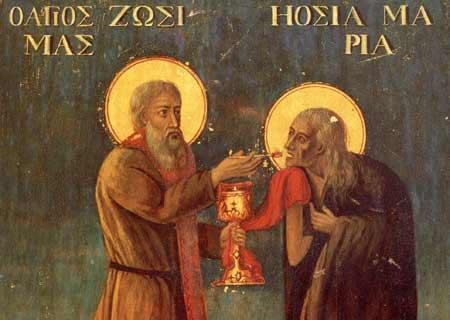 Why is commemorated Saint Mary of Egypt in Lent?
Why is commemorated Saint Mary of Egypt in Lent?
Saint Mary of Egypt is commemorated during Lent for a few reasons. First, it is par excellence an example of Christian repentance, for left dissolute life he was living, living a life of asceticism extreme desert and prayer, for love of Christ. Lent is also a time of penance and the last stage of effort, fasting, she is shown as an example, that we persevere.
Secondly, because it was found by St. Zosima during Lent, receiving last rites on Holy Thursday and died the same day, the Church has seen fit to fix a day to celebrate special biggest sinner who come to repentance.
Finally, we are told, from the day they entered the wilderness Saint Mary Jordan, until it was found by St. Zosima, 47 years have passed. Number 47 is important for Lent, as we are encouraged to imitate the life of the Holy during this period of fasting which lasts 40 days, for Lent until 7 days during Holy Week. It’s like Fathers we would encourage, wondering: If St. Mary’s led such a life for 47 years, we could not we do the same for only 47 days, to meet the Resurrection properly?
St. Mary of Egypt-life issues
Given the importance of St. Mary as a model of repentance, I found it necessary to point out some interesting aspects of her life. Her life was marked by St. Sophronius, who served as Patriarch of Jerusalem from 634 to 638. He says the Virgin Mary lived during his lifetime and he heard her story of a monk friend of St. Zosima, who met the saint.
One third of all record of his life, occupies the exposition in the first person, the Holy recounts his sinful life, converting and going into the wilderness.
Mary left home at 12 years, the prostitute in Alexandria for 17 years, and at age 29 was converted and left in the desert. Throughout time as prostitute was not received, in fact, paying for sexual favors, but survived by begging and spinning yarns in harsh environments. So it was in this condition only sinful indulgence of the flesh and not the material interests.
It is very likely that he had been baptized in childhood, since that is not spoken of any baptism after her conversion. And in her story, says, “I am protected from Baptism”. Moreover, we can assume that he received a Christian education, because first of repentance and a prayer addressed to Mary.
Mary conversion took place on the feast of the Exaltation of the Holy Cross in Jerusalem on September 14. We know that in 614, the Persians had stolen the Holy Cross in Jerusalem and was not returned until after the campaign against the Persian emperor Heraclius in 629.
Icon of the Mother of God, before whom Mary of Egypt was praying in the Holy Sepulcher Church, was placed “on a high place” in the courtyard before church built by Constantine the Great. It is said, for example, by the Pilgrim of Piacenza (approx. 570) and the Epiphany Monk (eighth century). Epiphany explicitly states that he saw “the left side of the church of St. Constantine … icon of the Theotokos, which was forbidden to enter the church of St. Mary on the day of the Exaltation of the Cross”.
Before going into the desert, Maria received Holy Communion in the Church of St. John the Baptist in the Jordan River near. The church, built by Emperor Anastasius I (491-518), was located about 8 km north of the Dead Sea and about 30 km from Jerusalem, the traditional site of Christ’s baptism by John the Baptist.
Maria lived 47 years in the desert and never met any man all these years. Thus, when it has met Zosima, it was 76 years and 53 years Zosima. Maria died when she was about 78 years old on April 1 Thursday Holy Week, which means that in that year, Resurrection fell on April 4.
Mary had great temptations in the desert for 17 years, ie an equal number of years in debauchery years in Alexandria.
Orthodox Church celebrates on Saint Mary of Egypt on April 1 and Sunday V of Lent, but it is honest and in the Catholic Church, on 2, 3, 9 or 10 of April, according to local tradition or the calendar used.
source: doxologia.ro
